C.S.P.S. Hall
Sokol Theater
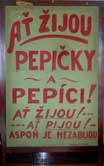 In 1879, 100+ members of C.S.P.S Lodge #12 “Čech” purchased a lot for $600 from sitting Mayor Charles Dawson, of the City of St. Paul. They then purchased and moved a wooden school house onto the property, and built a stage to accommodate the free expression of their culture, as well as their philosophy of “free thought.”
In 1879, 100+ members of C.S.P.S Lodge #12 “Čech” purchased a lot for $600 from sitting Mayor Charles Dawson, of the City of St. Paul. They then purchased and moved a wooden school house onto the property, and built a stage to accommodate the free expression of their culture, as well as their philosophy of “free thought.”
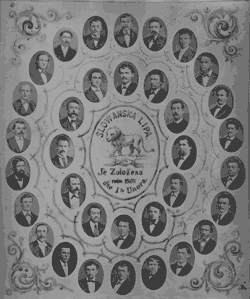 The first organizations of the Czech and Slovak immigrants in the West End were a Workers Union and Slovanska Lipa, a literary society. The library loan records document their book exchanges since that time, though in 1889 Slovanska Lipa was absorbed by C.S.P.S Lodge #12.
The first organizations of the Czech and Slovak immigrants in the West End were a Workers Union and Slovanska Lipa, a literary society. The library loan records document their book exchanges since that time, though in 1889 Slovanska Lipa was absorbed by C.S.P.S Lodge #12.
In 1882, Sokol St. Paul started as an extension of the international fitness movement, based on the early Greek model that bodily health produces moral and and mental health. Hence Sokol became the programming arm of the Czech and Slovak immigrant community, while C.S.P.S provided the financial foundation.
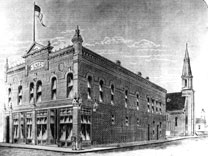 In 1886 that first hall burned, and planning began immediately to replace it with a two story structure in 1887. Through this time Sokols began an active program of theater, music performances, and entertainment in their native language, and even took programming to outlying Czech/Slovak communities throughout the Midwest. Our collection of over 200 “community” plays, published between 1880 and 1930 resides in our archives and is of great interest by the Art and Theater Institute in Prague. An inventory is underway. In 1893 the composer Antonin Dvorak was celebrated on our stage during his visit to the Midwest. In 1917 a third, mezzanine level meeting room was added, and is filled with original furnishings from the 1800’s. In 1975 the hall was threatened with demolition, and local Czechs and Slovaks, and their organizations, united with the West 7th Fort Road Federation and placed it under the protective arm of the National Register of Historic Sites, Building #77000763.
In 1886 that first hall burned, and planning began immediately to replace it with a two story structure in 1887. Through this time Sokols began an active program of theater, music performances, and entertainment in their native language, and even took programming to outlying Czech/Slovak communities throughout the Midwest. Our collection of over 200 “community” plays, published between 1880 and 1930 resides in our archives and is of great interest by the Art and Theater Institute in Prague. An inventory is underway. In 1893 the composer Antonin Dvorak was celebrated on our stage during his visit to the Midwest. In 1917 a third, mezzanine level meeting room was added, and is filled with original furnishings from the 1800’s. In 1975 the hall was threatened with demolition, and local Czechs and Slovaks, and their organizations, united with the West 7th Fort Road Federation and placed it under the protective arm of the National Register of Historic Sites, Building #77000763.
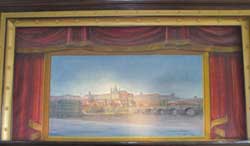 In 1931, Vic Hubal, Sr. painted six backdrops that evoked scenes of his native Bohemia. Their unique “fly” (raise and lower) system of pulley and rope is hand operated, an historic theatric rarity; only the front backdrop of the Charles Bridge in Prague has a counterweight to make the task easier. The C.S.P.S. Hall stage also has two sets of “splatter flats.” One, the “cool” (grey), the other “warm” (beige) are ten feet tall with nine pieces each. Unlike modern hinges sets, these are lashed together to form sets. The scenic assets also include one roofed cottage, several flats of “brick,” and three trees. The footlights were electrified when the stage was relocated in the 1917 addition that added the mezzanine meeting room and the grand staircase.
In 1931, Vic Hubal, Sr. painted six backdrops that evoked scenes of his native Bohemia. Their unique “fly” (raise and lower) system of pulley and rope is hand operated, an historic theatric rarity; only the front backdrop of the Charles Bridge in Prague has a counterweight to make the task easier. The C.S.P.S. Hall stage also has two sets of “splatter flats.” One, the “cool” (grey), the other “warm” (beige) are ten feet tall with nine pieces each. Unlike modern hinges sets, these are lashed together to form sets. The scenic assets also include one roofed cottage, several flats of “brick,” and three trees. The footlights were electrified when the stage was relocated in the 1917 addition that added the mezzanine meeting room and the grand staircase.
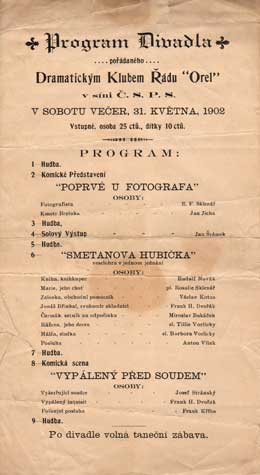 We are fortunate to have a very interesting accumulation of ledger books, scripts and programs dealing with theater productions at the C.S.P.S Hall. The first program dates from 1902 and is a review in nine acts: 5 musical numbers, 2 comic skits, a one act comedy Smetanova Hubička (Sweet Kiss), and a solo act by Jan Šrámek. In addition, there are 203 different scripts in the Czech language that were considered for productions, and at least 65 programs that detail the author, cast, director. Some indicate that there would be a dance afterwards which would make for a long evening! Many of the scripts are comedies dealing with village life in Bohemia prior to 1900, and well suited to community theater production. The earliest production we can document consisted of three short one-act comedic plays performed in 1908. The plays were Poprvé u Fotografa (First Time Sitting for the Photographer), Smetanova Hubička (Sweet Kiss) and Vypáleny Před Souderu (Burned before the Court).
We are fortunate to have a very interesting accumulation of ledger books, scripts and programs dealing with theater productions at the C.S.P.S Hall. The first program dates from 1902 and is a review in nine acts: 5 musical numbers, 2 comic skits, a one act comedy Smetanova Hubička (Sweet Kiss), and a solo act by Jan Šrámek. In addition, there are 203 different scripts in the Czech language that were considered for productions, and at least 65 programs that detail the author, cast, director. Some indicate that there would be a dance afterwards which would make for a long evening! Many of the scripts are comedies dealing with village life in Bohemia prior to 1900, and well suited to community theater production. The earliest production we can document consisted of three short one-act comedic plays performed in 1908. The plays were Poprvé u Fotografa (First Time Sitting for the Photographer), Smetanova Hubička (Sweet Kiss) and Vypáleny Před Souderu (Burned before the Court).
